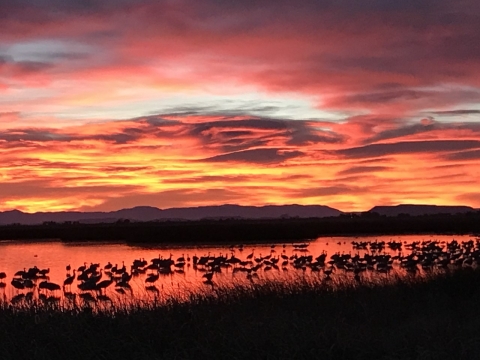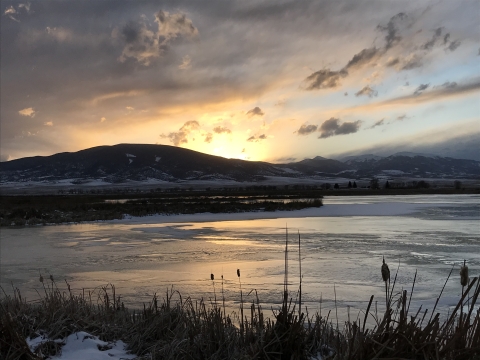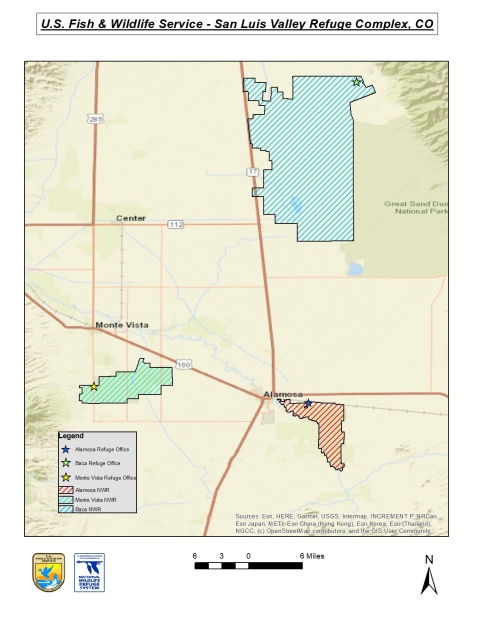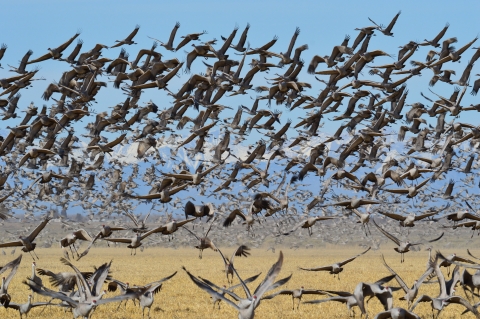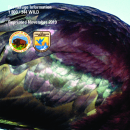Visit Us
Wildlife Viewing & Events (9/25/2025)
* Public Viewing Areas –
* “Wildlife Drive” located east of the refuge office, is currently being dried for an upcoming prescribed burn prescribed burn
A prescribed burn is the controlled use of fire to restore wildlife habitat, reduce wildfire risk, or achieve other habitat management goals. We have been using prescribed burn techniques to improve species habitat since the 1930s.
Learn more about prescribed burn . Spring Creek Pond on the south end of the Wildlife Drive remains full and holding good numbers of waterfowl.
* “Highway 15 Pullouts” located on South Hwy 15 are partially wet and will soon be full, providing for crane loafing.
* “8S Pullout” located along County Rd 8S just east of Hwy 15 has agriculture fields where some waterfowl and cranes are feeding in. Occasional herds of elk have been in the area as well.
* “7S Pullout” located between County Rd 2E and 3E has agriculture fields where some waterfowl and cranes are feeding in.
Monte Vista Refuge General Information Brochure
The small office and visitor contact station at the Refuge is located at the start of the Wildlife Drive. The visitor contact station is operated by volunteers and may not be open on a regular schedule. All brochures and refuge information will be posted in the kiosk located near the entrance of the Wildlife Drive.
Refuge Hours:
Wildlife Drive, Trails, Wildlife Viewing Pullouts are open One hour before Sunrise to One hour after Sunset.
For more information, please call us at 719-589-4021 or by email at Alamosa@fws.gov.
Monte Vista Refuge General Information Brochure
You can also contact Friends of the San Luis Valley Refuges for more information.
Location and Contact Information
About Us
About the Refuge
Monte Vista National Wildlife Refuge is located in the San Luis Valley, a high mountain basin located in south-central Colorado. It’s one of three national wildlife refuges in the Valley that provides crucial feeding, resting, and breeding habitat for over 200 bird species and other wildlife. Alamosa and Monte Vista Refuges are located at the south-central end of the Valley and Baca Refuge is located at the north end.
About the Complex
The San Luis Valley National Wildlife Refuge Complex is made up of the Alamosa, Monte Vista, and Baca National Wildlife Refuges and is an area set aside for migratory birds and resident wildlife. These Refuges are part of the National Wildlife Refuge System, a network of lands set aside and managed by the U.S. Fish and Wildlife Service specifically for wildlife. The Refuge System is a living heritage, conserving wildlife, and habitat for people today and generations to come.
The 12,026 acre Alamosa National Wildlife Refuge includes wetland areas, riparian riparian
Definition of riparian habitat or riparian areas.
Learn more about riparian corridors, wet meadows, and river oxbows. The wetland and river habitats provide a wildlife oasis in this dry region. These habitats support a variety of wildlife, including songbirds, water birds, raptors, deer, beavers, coyotes, and more.
The artificially created wetlands on Monte Vista National Wildlife Refuge’s 14,804 acres are intensively managed to provide habitat for a wide variety of waterfowl and other water birds. Mallards, pintails, teals, and Canada geese are common, as are American avocets, killdeers, white-faced ibises, egrets, and herons. Irrigation canals and wells provide precious water to maintain this important habitat.
The 93,000 acre Baca National Wildlife Refuge is a highly diverse combination of shrublands, grasslands, wet meadows, playa wetlands, and riparian areas. This Refuge was set aside not only as a haven for migratory birds and resident wildlife, but also as an important piece in a broader conservation effort to protect the wildlife, habitat, and water of the north and eastern portions of the San Luis Valley.
The Valley, sitting at 7,800 feet, extends over 100 miles from north to south and 50 miles from east to west. Three mountain ranges surround the Valley – the Sangre de Christo to the east, the San Juan to the west, and the Saguache to the north. At sunset, the highest peaks of the Sangre de Christo range take on a blood red glow which inspired the Spanish explorers to name them after the “Blood of Christ.”
The surrounding mountains feed the arid valley with precious surface water and replenish an expansive underground reservoir. The mountain snow melt and artesian wells provide needed water to the agricultural community and to the rivers, creeks, and wetlands that thread across the valley floor.
These Refuges contribute to over 560 refuges in the National Wildlife Refuge System – a network of lands set aside and managed by the U.S. Fish and Wildlife Service specifically for wildlife. The Refuge System is a living heritage, conserving wildlife and habitat for people today and generations to come.
Our Organization
Our Species
Sandhill Cranes
Each year, thousands of Sandhill Cranes descend upon the wetlands and agricultural fields of the Monte Vista National Wildlife Refuge during their biannual migration to rest and fuel up for the next leg of their journey. During the spring migration, the refuge will host ninety-five percent, 18,000-21,000, of the Rocky Mountain population of the Greater Sandhill Cranes and another 5,000-6,000 Lesser Sandhill Cranes. This stop-over at the Monte Vista Refuge is critical for the cranes during their migration. At this time of year, most food sources and quality crane habitat are either under snow or are frozen. However, on the refuge, wetlands are filled, and grain fields are mowed to provide the cranes the two elements needed for their migration… food and roosting cover. The peak migration period of cranes on the Monte Vista Refuge is around the first week of March and again around the second week of October.


